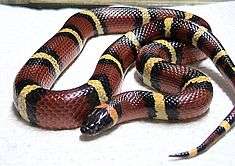Mexican milk snake
| Mexican milk snake | |
|---|---|
 | |
| Scientific classification | |
| Kingdom: | Animalia |
| Phylum: | Chordata |
| Subphylum: | Vertebrata |
| Class: | Reptilia |
| Order: | Squamata |
| Suborder: | Serpentes |
| Family: | Colubridae |
| Subfamily: | Colubrinae |
| Genus: | Lampropeltis |
| Species: | L. triangulum |
| Subspecies: | L. t. annulata |
| Trinomial name | |
| Lampropeltis triangulum annulata Kennicott, 1861 | |
Lampropeltis triangulum annulata, commonly known as the Mexican milk snake, is a nonvenomous species of milk snake.
Geographic range
It is native primarily to northeastern Mexico in Coahuila, Tamaulipas and Nuevo León, but it can be found as far north as the United States, in southwestern Texas.
Description
The Mexican Milk Snake has distinct red, black and cream colored banding, which sometimes leads to it being called a coral snake mimic. In some localities the cream colored banding can be more yellow, and in other areas it can be more orange. They grow to approximately 30 inches (76 cm) in length. It is not venomous, contrary to the coral snake which looks pretty similar to this milk snake. The coral snake's red and yellow bands are adjacent, while the milk snake's red and black bands are adjacent. Distinguishing between the two, therefore, is often taught with the mnemonic device "red touches/on black, friend of Jack; red touches/on yellow, kill a fellow". (A variation is: "Red on yellow kills a fellow. Red on black venom lack."[1][2])
Behavior
Mexican milk snakes are generally nocturnal, and prefer to hide when the temperatures are higher, becoming most active in the cooler periods of the spring and fall. They eat primarily rodents and lizards, but will sometimes eat other snakes. Their choice of habitat is semi-arid brush areas, with sandy soils.
Breeding occurs on rainy spring evenings, and approximately 50 days later, the female will lay 4-10 eggs which will incubate for 55–60 days before hatching. Newborns are around 6-7 inches (15–17 cm) long.
In captivity
The Mexican Milk Snake adapts well to captive care, and its smaller size and striking colorations can make it an attractive choice for a pet snake. They are normally docile, and not typically apt to bite or expel musk.
References
| Wikimedia Commons has media related to Lampropeltis triangulum annulata. |
- ↑ Life's Better Outdoors, South Carolina Department of natural resources (see FAQ's. -- "are there any visual clues"..........). Retrieved July 15, 2015
- ↑ Medical-Surgical Nursing: Patient-Centered Collaborative Care by Donna D. Ignatavicius, M. Linda Workman (pages 141-142)